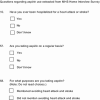Population Trends in Aspirin Use for Cardiovascular Disease Prevention 1980-2009: The Minnesota Heart Survey
- PMID: 26702085
- PMCID: PMC4845283
- DOI: 10.1161/JAHA.115.002320
Population Trends in Aspirin Use for Cardiovascular Disease Prevention 1980-2009: The Minnesota Heart Survey
Abstract
Background: Daily low-dose aspirin is recommended for primary prevention of myocardial infarction and stroke in higher-risk patients. Population trends in aspirin use for cardiovascular disease (CVD) prevention in an urban population (Minneapolis/St. Paul, 2010 population 2.85 million) from 1980 to 2009 were evaluated.
Methods and results: Surveys of randomly selected adults aged 25 to 74 years were collected at 5-year intervals. Self-reports of regular aspirin use for CVD prevention and history of CVD were obtained. Six cross-sectional surveys included 12 281 men and 14 258 women. Age-adjusted aspirin use for primary prevention increased during this period from 1% to 21% among men and 1% to 12% among women. Aspirin use was highest in those aged 65 to 74 years. For secondary prevention, age-adjusted aspirin use increased from 19% to 74% among men and 11% to 64% among women. While data are based on self-report, a substudy using a biochemical indicator of aspirin use (serum thromboxane B2) supports the validity of self-report.
Conclusions: Aspirin for CVD prevention is commonly used by a large and growing portion of the general population. It is not known if this is based on professional advice or self-prescribed use. It is also likely that many who would benefit do not use aspirin and others use aspirin inappropriately.
Keywords: aspirin; epidemiology; prevention.
© 2015 The Authors. Published on behalf of the American Heart Association, Inc., by Wiley Blackwell.
Figures



Comment in
-
Within-the-Clinic Shared Decision for an Over-the-Counter Medication.J Am Heart Assoc. 2015 Dec 23;4(12):e002927. doi: 10.1161/JAHA.115.002927. J Am Heart Assoc. 2015. PMID: 26702080 Free PMC article. No abstract available.
References
-
- Go AS, Mozaffarian D, Roger VL, Benjamin EJ, Berry JD, Borden WB, Bravata DM, Dai S, Ford ES, Fox CS, Franco S, Fullerton HJ, Gillespie C, Hailpern SM, Heit JA, Howard VJ, Huffman MD, Kissela BM, Kittner SJ, Lackland DT, Lichtman JH, Lisabeth LD, Magid D, Marcus GM, Marelli A, Matchar DB, McGuire DK, Mohler ER, Moy CS, Mussolino ME, Nichol G, Paynter NP, Schreiner PJ, Sorlie PD, Stein J, Turan TN, Virani SS, Wong ND, Woo D, Turner MB; on behalf of the American Heart Association Statistics Committee and Stroke Statistics Subcommittee . Heart disease and stroke statistics—2013 Update: a report from the American Heart Association. Circulation. 2013;127:e6–e245. - PMC - PubMed
-
- Farley TA, Dalal MA, Mostashari F, Frieden TR. Deaths preventable in the U.S. by improvements in use of clinical preventive services. Am J Prev Med. 2010;38:600–609. - PubMed
-
- Baigent C, Blackwell L, Collins R, Emberson J, Godwin J, Peto R, Buring J, Hennekens C, Kearney P, Meade T, Patrono C, Roncaglioni MC, Zanchetti A. Aspirin in the primary and secondary prevention of vascular disease: collaborative meta‐analysis of individual participant data from randomised trials. Lancet. 2009;373:1849–1860. - PMC - PubMed
-
- Steering Committee of the Physicians’ Health Study Research Group . Final report on the aspirin component of the ongoing Physicians’ Health Study. N Engl J Med. 1989;321:129–135. - PubMed
-
- Ridker PM, Cook NR, Lee IM, Gordon D, Gaziano JM, Manson JE, Hennekens CH, Buring JE. A randomized trial of low‐dose aspirin in the primary prevention of cardiovascular disease in women. N Engl J Med. 2005;352:1293–1304. - PubMed
Publication types
MeSH terms
Substances
Grants and funding
LinkOut - more resources
Full Text Sources
Medical

